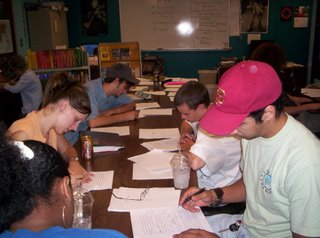

Georgia Performance Standards Key Words: ELALRL1 - Evidence, ELALRL2 - Theme, ELALRL3 - Connections, ELALRL4 - Compose, ELALRL5 - Vocabulary






Opening: Call me over to your work area so you can answer the following questions.
a. What is original sin?
b. How did the Puritans feel about original sin?
c. How did the Rationalists differ from the Puritans?
d. What are the main themes of Romanticism? Georgia Performance Standard ELAALRL2 states that you should be able to identify themes and support them with evidence. I will expect that you can do this at this point.
That should have been easy.
Now we are going to investigate the central themes of another group of Romantics called the Transcendentalists.
You will continue to address the following Georgia Performance Standard:
ELAALRL2 The student identifies, analyzes, and applies knowledge of theme in a work of American literature and provides evidence from the work to support understanding.
Mini-Lesson:
By the mid-1800s, the United States was still in search of its literary identity. America had popular writers like Washington Irving, but they still did not have the heavy hitters to match up with some of Englands poets and essayists. The Unites States wanted to declare literary independence from Enlgand, much like the political separation that happened almost one hundred years earlier.
It was a good time for Americans to want to assert themselves in the literary world. Learning was very popular at the time. Most Americans wanted to improve their minds in one way or the other. Some of the most popular things to do were attending lectures on topics from astronomy to botany to physics to philosophy. Groups pushing for the abolition of slavery and increased rights for women were also forming during this time.
This strive for independence began for the most part during a hiking trip and dinner with a guestlist that would include some of the United States' most famous literary figures: Nethaniel Hawthorne, Herman Mellville, and Oliver Wendell Holmes. It was at this outing that these men decided that the United States should have writers as good as England's William Shakespeare, and that this would never happen unless they made an effort to do so. These men's dreams would soon be realized in two separate groups -- The Transcendentalists and the Dark Romantics, sometimes known as "anti-transcendentalists".
The Transcendentalists:
The Transcendentalists were Romantics who adopted philosophies from many other places and cultures. They believed that the individual human mind was one of the most powerful instruments in the world, and that the individual mind was connected to all others through what was known as the "oversoul", a collection of everyone's soul that we all share.
Transcendentalists believed that God spoke through people's minds and their hard work. Since they believed this, they also believed that every human was absolutely good and pure. They did not believe that the origianl sin committed by Adam and Eve made the rest of us sinners. Why would God communicate through an impure mind? They also believed that God could communicate to people through nature and a persons intuition.
they believed this, they also believed that every human was absolutely good and pure. They did not believe that the origianl sin committed by Adam and Eve made the rest of us sinners. Why would God communicate through an impure mind? They also believed that God could communicate to people through nature and a persons intuition.
Since God spoke through individuals, Transcendentalists did not belive that institutions like the governemnet or organized religion were effective. They believed that if a person was truly in touch with their surroundings, they could transcend these physical and man-made things to connect with God. The Transcendentalists' optimism and overall trust in the goodness of all people made them popular with outsiders who would often enjoy their lectures.
Please read the following (all of these can be found in the red anthology):
from "Nature" by Ralph Waldo Emerson
from "Self-Reliance" by Ralph Waldo Emerson
5. When you are through reading, post a 1-2 paragraph response to each piece of writing to your blog. Be sure to concentrate more on what you thought of each piece of writing. Try to include at least one piece of direct evidence with each response (remember standard #1). This should be something that stuck out to you about the particular piece of writing.
6. Next, write explain how each piece is a good example of Transcendentalism by identifying the central themes I described earlier in the post. Use what you read above, and prove that each piece is a good example with a paragraph supported with direct evidence (one paragraph each).
NEXT!!
Check this guy out. If you do not see the video here, you can find it in my assignments folder. I have called it Wilderness:
7. How can you apply Transcendental philosophy to the man in this video? I'm sure you could easily spend a couple paragraphs telling me how. I also know it would be easy for you to back up whatever you say with direct evidence from the texts you have already read. If you are really into it, you might read a little of Henry David Thoreau's Walden. Just choose a couple sections you think you would like.
Once you are finished, leave me a comment so I know to view your work.
 I would once again like to congratulate everyone on their efforts so far. Below are some great examples of descriptive writing that I have had the pleasure to read this week.
I would once again like to congratulate everyone on their efforts so far. Below are some great examples of descriptive writing that I have had the pleasure to read this week. I finished this book last night, and I still say it was not as good as Kafka on the Shore, which I would highly reccomend to other people. I still like the way Murakami writes, and I kind of wish I could read his books in Japanese since I'm sure I'm missing a lot reading a translation.
I finished this book last night, and I still say it was not as good as Kafka on the Shore, which I would highly reccomend to other people. I still like the way Murakami writes, and I kind of wish I could read his books in Japanese since I'm sure I'm missing a lot reading a translation.


You should be able to see that if I had continued stretching out my entire outline, I would have a map of my paper. This work will make it simple for me to begin my first draft of my research paper since I have a list of everything that will go into it, right down to the notes I will use. Keep in mind that each of these green sections are likely to be paragraphs including the paraphrased and directly quoted material you have collected. Creating an outline like this takes time, but it will make the writing easier in the long run.


 A score of 90 – 100 will be awarded to posts that: are original, complete, and contain the required direct textual evidence. Posts scoring in this range illustrate students’ opinions and responses to the text that are supported by facts that the student has fully analyzed.
A score of 90 – 100 will be awarded to posts that: are original, complete, and contain the required direct textual evidence. Posts scoring in this range illustrate students’ opinions and responses to the text that are supported by facts that the student has fully analyzed.